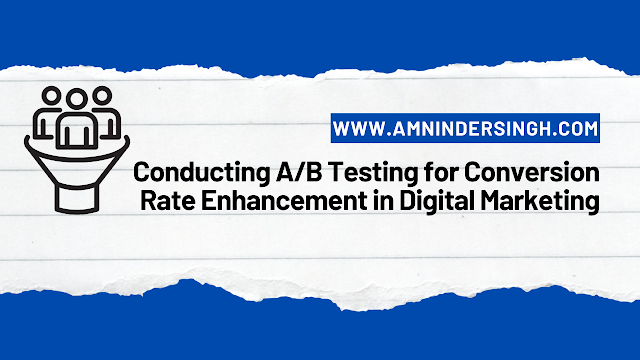A/B testing, also known as split testing, is a fundamental practice in digital marketing aimed at optimizing conversion rates.
It involves comparing two versions (A and B) of a webpage or marketing element to determine which one performs better.
By systematically testing and analyzing various elements, businesses can make data-driven decisions to improve user engagement and conversion rates.
In this article, we will explore the significance of A/B testing and provide a step-by-step guide on how to conduct effective tests for conversion rate enhancement.
The Significance of A/B Testing
A/B testing is more than just a tool; it’s a strategy that can have a profound impact on your digital marketing efforts. Here’s why A/B testing is so crucial:
1. Data-Driven Decision-Making: A/B testing allows you to make decisions based on real user data rather than assumptions or intuition. This results in more accurate and effective optimizations.
2. Improved User Experience: By testing different elements, you can refine your website or marketing materials to better meet user needs and expectations.
This leads to a more enjoyable user experience.
3. Increased Conversions: A/B testing helps identify which changes lead to higher conversion rates. Whether it’s a button color, headline, or CTA placement, optimizing these elements can significantly boost conversions.
4. Enhanced ROI: By improving conversion rates, you get more value from your marketing budget. A/B testing can lead to higher ROI by maximizing the impact of your campaigns.
5. Competitive Advantage: Businesses that regularly A/B test have an advantage over competitors who rely on static designs or strategies. They can adapt and evolve to meet changing user preferences.
Steps for Conducting A/B Testing
A/B testing involves a systematic approach to experimentation. Here’s a step-by-step guide on how to conduct effective A/B tests:
1. Identify Your Goal:
Begin by defining a clear, specific goal for your A/B test. What do you want to improve? It could be increasing click-through rates, boosting email sign-ups, or enhancing product purchases.
2. Select a Variable to Test (the “Challenger”):
Choose a single element or variable to test. Common elements to test include headlines, images, call-to-action (CTA) buttons, form fields, page layouts, and email subject lines. The variation you test is referred to as the “challenger.”
3. Create Variations (A and B):
Develop two distinct versions of the element you’re testing: Version A (the control or original) and Version B (the challenger with the proposed change). Ensure that only one variable is different between the two versions.
4. Split Your Audience:
Randomly divide your audience into two groups: Group A and Group B. Each group will see one of the variations (A or B). It’s essential to ensure that the audience split is representative and unbiased.
5. Implement the Test:
Deploy both versions to your audience simultaneously. This may involve using A/B testing software, content management systems, or email marketing platforms, depending on the test’s scope.
6. Collect Data:
Allow the test to run for a sufficient duration to gather a significant amount of data. The duration depends on your specific goals and the volume of traffic or interactions you receive.
7. Analyze Results:
After collecting enough data, analyze the results to determine which variation performed better in achieving your goal. Use statistical significance tools to ensure that the differences observed are not due to chance.
8. Implement the Winner:
If the challenger (Version B) outperforms the control (Version A) and the results are statistically significant, implement the changes permanently. If not, iterate and create a new challenger for further testing.
9. Repeat and Iterate:
A/B testing is an ongoing process. Continuously identify new variables to test and refine your strategies based on data-driven insights. Even small optimizations can accumulate to create significant improvements over time.
10. Document and Share Learnings:
Keep a record of your A/B test results, including what was tested, the data collected, and the conclusions drawn. Share these insights with your team to inform future marketing efforts.
Common A/B Testing Pitfalls to Avoid
While A/B testing can be highly effective, it’s essential to be aware of common pitfalls:
1. Testing Too Many Variables: Focus on a single variable in each A/B test to ensure that you can attribute any changes in performance to that specific element.
2. Not Running Tests for a Sufficient Duration: Make sure you collect data for an adequate period to account for variations in user behavior over time.
3. Ignoring Statistical Significance: Rely on statistical significance to determine if the observed differences are significant or if they could have occurred by chance.
4. Not Segmenting Audiences: Different user segments may respond differently to changes. Segment your audience appropriately to get more accurate insights.
5. Neglecting Mobile Users: Ensure that your A/B tests consider the mobile user experience, as mobile devices play a significant role in online interactions.
Conversion Rate Enhancement : Conclusion
A/B testing is a powerful tool for enhancing conversion rates and optimizing digital marketing efforts.
By systematically testing and analyzing various elements, you can make informed, data-driven decisions that improve user experiences, increase conversions, and ultimately drive business success.
Remember that A/B testing is an ongoing process, and each test contributes to a more refined and effective digital marketing strategy.
Embrace the power of experimentation and watch your conversion rates soar.
This article is part of our Website and Landing Page Optimization Module.
Module 3: Website and Landing Page Optimization
3.1 Principles of Effective Website Design
3.2 Enhancing User Experience (UX)
3.3 Ensuring Mobile Responsiveness
3.4 Crafting High-Converting Landing Pages
3.5 Conducting A/B Testing for Conversion Rate Enhancement

